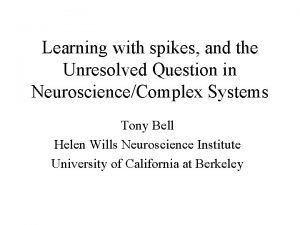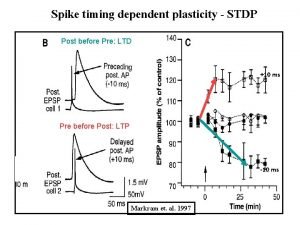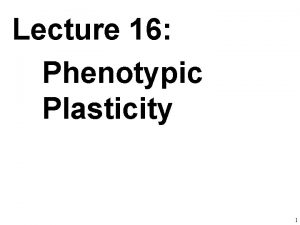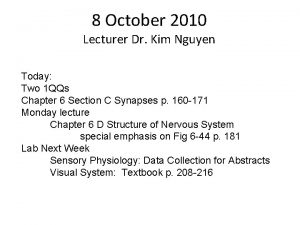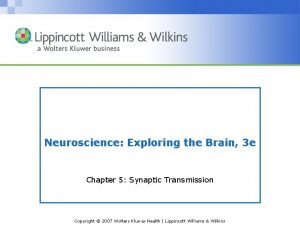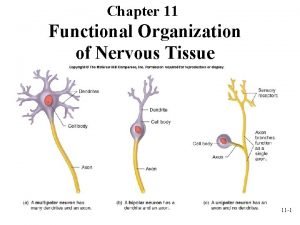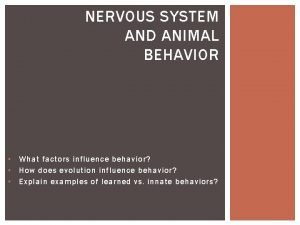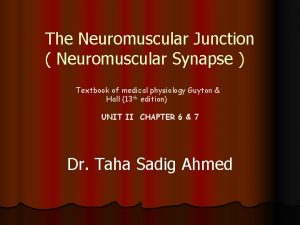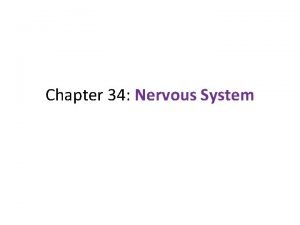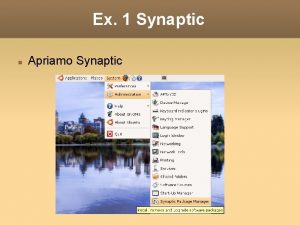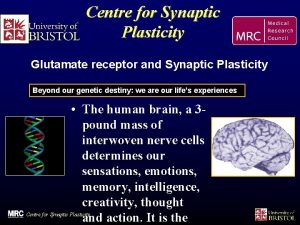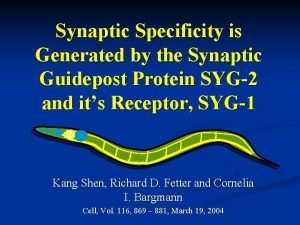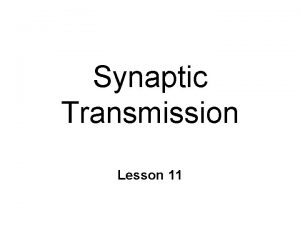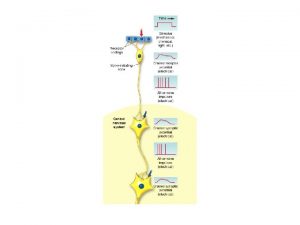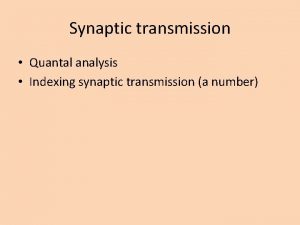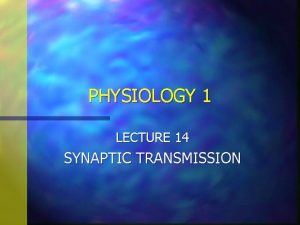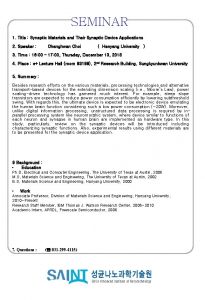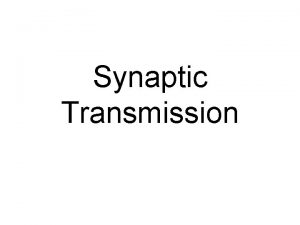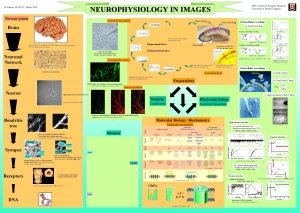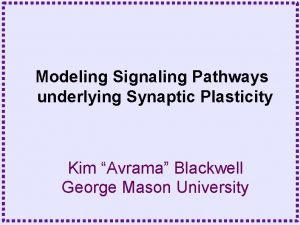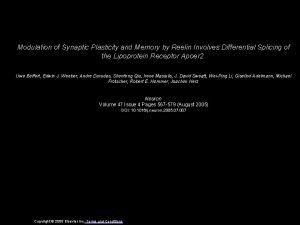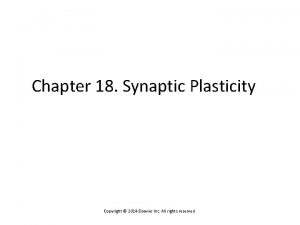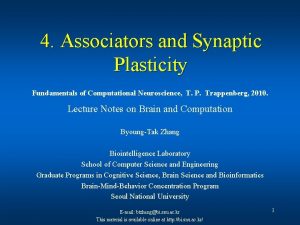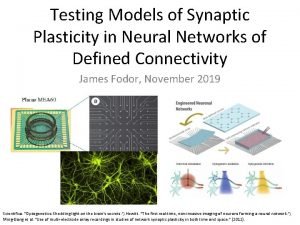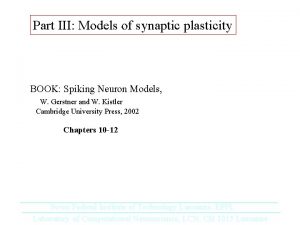Synaptic Plasticity The term synaptic plasticity refers to

























- Slides: 25



Synaptic Plasticity

The term synaptic plasticity refers to the variability of the strength of a signal transmitted through a synapse. Facilitation: The amplitude of the postsynaptic response increases when the postsynaptic cell is activated several times in quick succession Important Questions: 1) Presynaptic or Postsynaptic? 2) Underlying Mechanisms?

Time Course of Activity Induced Changes Synaptic plasticity is classified according to the duration over which the effect persists. SHORT TERM CHANGES Facilitation appears instantly, and is of short duration (100 ms) Depression recovers and Augmentation dissipates within 10 seconds Post-tetanic potentiation (PTP) can last for more than 10 minutes LONG TERM CHANGES Long-term potentiation (LTP) and Long-term Depression (LTD) last from minutes to beyond 10 hours

Short-term Changes in Signaling Most extensively studied at synapses in the peripheral nervous system (chick ciliary ganglion, skeletal muscle) Changes have also been demonstrated throughout the CNS § § Facilitation Augmentation Post-tetanic Potentiation (PTP) Depression Typically last for periods ranging from milliseconds (facilitation) to tens of minutes (PTP).

Facilitation of Transmitter Release Most immediate effect of repetitive stimulation is synaptic facilitation Amplitudes of EPPs increase progressively Frog NMJ Low Ca 2+ The effect outlasts the stimulus train Cause: increased mean number of quanta of transmitter released by the presynaptic terminal, probably by increasing the probability of release and perhaps increasing the number of release sites.

Augmentation of Synaptic Transmission Slower phase of facilitation Increase in synaptic potential amplitude comes on more slowly than facilitation Decays over a much longer time period (time constant of 5 -10 s)

Post-Tetanic Potentiation (PTP) Curarized Relatively long train of high frequency stimuli (Tetanus) Refers to increased transmitter (ACh) release from presynaptic terminal due to prior stimulation (similar to facilitation and augmentation) Differs from facilitation and augmentation in that its onset is considerably delayed § (reaches maximum several seconds after stimulation ceases, lasts for tens of minutes Blocked by removal of calcium from bathing solution, but PTP occurs in the presence of TTX (w/ depolarizing pulses) Chick ciliary ganglion

The frog neuromuscular junction (NMJ) provides an excellent model for studying the role of receptors in synaptic transmission. The preparation has a large postsynaptic element, making it relatively easy to monitor changes in synaptic transmission in the form of end plate potentials (EPPs). Unlike action potentials, EPPs are not all-or-none responses; instead, they reflect small changes in synaptic transmission. To observe EPPs, antagonists must be applied to the NMJ to compete with neurotransmitter binding to postsynaptic receptors. This competition prevents the depolarization of the postsynaptic membrane from reaching threshold and thus, eliminates action potentials. Curare is an example of a non-depolarizing muscle relaxant which blocks the nicotinic receptors, one of the two types of cholinergic (acetylcholine) receptors on the post synaptic membrane of the neuromuscular junction.

Depression of Transmitter Release Curarized Synaptic depression can occur if the number of quanta released by a train is large Amplitudes of EPPs decrease progressively with repetitive stimulation Frog NMJ High Ca 2+ This effect also outlasts the stimulus train (not shown) Thought to be caused by depletion of vesicles from the presynaptic terminal during the conditioning train, and reduced release efficacy.

Short Term Synaptic Plasticity § Synaptic enhancement (facilitation, augmentation, potentiation) § ALL presynaptic mechanisms § Increase in mean number of transmitter quanta without change in quantal size or postsynaptic effectiveness Increased probability of release and perhaps an increased number of release sites § Crucial role of calcium Residual presynaptic intracellular calcium § Synaptic depression § MOSTLY presynaptic § Depletion of pool of vesicles § Decrease in number of transmitter quanta Decrease in probability of release and perhaps a reduced release efficacy

Long-term Changes in Signaling In the CNS, repetitive activity produces changes in synaptic efficiency that last much longer than seen at peripheral synapses - ranging from minutes to hours. Hippocampal LTP – best studied of any form of plasticity. Much of the research predicated on assumption that hippocampal LTP is the mechanism for learning. Cortex – both LTP and LTD of pyramidal cell excitatory synapses Amygdala – LTP closely linked to fear conditioning Cerebellum – mostly LTD of Purkinje cell EPSPs. Some LTP at Purkinje cell excitatory synapses and LTP of inhibitory synapses May represent neural substrates for learning and memory s Long-Term Potentiation § Long-Term Depression

LTP and LTD in vitro vs. in vivo Acute Brain Slice Prep, Slice culture, Co-Cultured cells § Limitations – mimics an intact system § removal of normal inputs and milieu § addition of blockers such as picrotoxin or tetrodotoxin § lack normal outputs § Advantages – clear and interpretable response § Single EPSP/IPSP is unequivocal – it’s there or it isn’t § No “contamination” from other inputs Intact anesthetized or freely moving animal § Don’t know “effective” stimulation § Can study effects of stimulation on behavior

Long-term Potentiation Why the hippocampus? First described by Bliss and Lomo (1973) at glutamatergic synapses in the hippocampal formation. High frequency stimulation of inputs to dentate gyrus cells produces an increase in the amplitude of EPSPs lasting for hours or days. Homosynaptic LTP The LTP effect also observed in neocortex.

Long-term Potentiation in CA 1 Requires only a brief tetanus, is input specific, and can last many weeks

Associative LTP and Learning? Associative LTP is the strengthening of the connection between two neurons that have been simultaneously active

Associative LTP Source “A” Source “B” Source “C”

Mechanism(s) for LTP in CA 1 Increased effectiveness of existing postsynaptic AMPA receptors, perhaps by phosphorylation. PKC phosphorylation of the AMPA receptor changes the protein in some way that increases the ionic conductance of the channel. Insertion of completely new AMPA receptors into the membrane Changes to the structure of the synapse- new buds form on postsynaptic dendrites, axons “sprout” and form multiple synapses.

Significance of Changes in Synaptic Efficacy LTP (and LTD) are of particular interest because learning and memory are thought to involve long-term changes in synaptic efficacy. A number of correlations have been shown between spatial learning in intact animals and LTP in hippocampal slices (ie. , both blocked by NMDA or m. Glu Receptor antagonists) LTP in amygdala strongly associated with aversive (“fear”) conditioning • rats trained to associate foot shock with a sound exhibit an exaggerated auditory startle reflex • cells in the amygdala display LTP-like increase in their synaptic responses to stimulation of auditory inputs. • both are blocked by NMDA receptor antagonists.

Types of Long-term Depression Linden & Connor, 1995

Cerebellar Anatomy EXCITATORY Parallel Fibers (gr c. ) Climbing Fibers INHIBITORY Purkinje Cells Stellate Cells Basket Cells

Long-term Depression in the Cerebellum After pairing, there is an LTD of the response to parallel fiber stimulation

Mechanism of LTD in the Cerebellum X = no LTP AMPA receptors are internalized: Postsynaptic effect CF activates Purkinje Cell, Na+ entry depolarizes the dendrite, and voltage-gated Ca 2+ channels are activated. PF activation (glutamate) also increases Na+ entry, through AMPA receptors. The glutamate also directly activates m. Glu. R’s in the membrane. This generates DAG which activates PKC phosphorylates proteins--somehow leading to a decreased number of AMPA receptors in the postsynaptic membrane.

“Hebbian Rules” for Synaptic Modification Donald Hebb (1940 s) When the presynaptic axon is active, and at the same time the postsynaptic neuron is strongly activated by other inputs, then the synapse formed by the presynaptic axon is strengthened “Neurons that fire together wire together” When the presynaptic axon is active, and at the same time the postsynaptic neuron is weakly activated by other inputs, then the synapse formed by the presynaptic axon is weakened “Neurons that fire out of sync lose their link”
 Spike timing dependent plasticity
Spike timing dependent plasticity Earth asthenosphere
Earth asthenosphere Unto us spike milligan
Unto us spike milligan Consistency limit test
Consistency limit test Arash ashari
Arash ashari Plasticity in earth's layers
Plasticity in earth's layers Adaptive plasticity
Adaptive plasticity Plasticity
Plasticity Becker
Becker Synaptic integration
Synaptic integration Wolters kluwer
Wolters kluwer Conclusion of screenless display
Conclusion of screenless display Synaptic potential
Synaptic potential Synaptic transmission quiz
Synaptic transmission quiz Neuromuscular junction
Neuromuscular junction Thin filament
Thin filament Ryan triplett
Ryan triplett Duodenum
Duodenum Synaptic pruning
Synaptic pruning Synaptic gutter
Synaptic gutter Reconstruction refers to the
Reconstruction refers to the The term “minority majority” refers to the fact that
The term “minority majority” refers to the fact that Data refers to
Data refers to The term prehistory refers to the period before
The term prehistory refers to the period before Diversity refers to
Diversity refers to Motivation is defined as:
Motivation is defined as:
